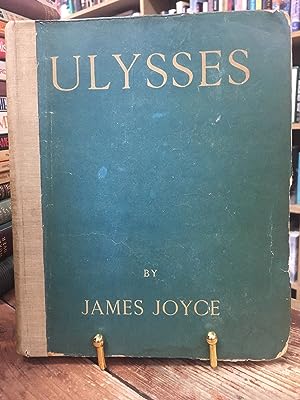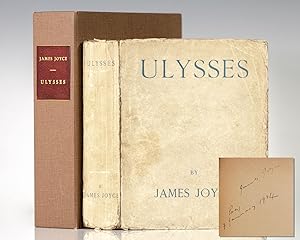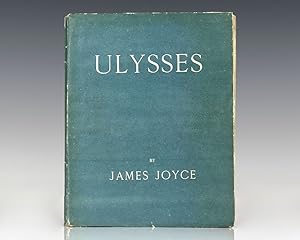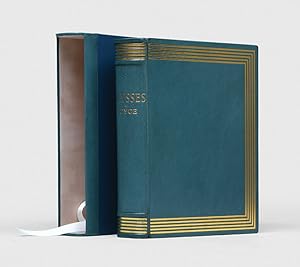ulysses di joyce, Prima edizione, shakespeare (24 risultati)
FeedbackFiltri di ricerca
Tipo di articolo
- Tutti i tipi di prodotto
- Libri (24)
- Riviste e Giornali (Nessun altro risultato corrispondente a questo perfezionamento)
- Fumetti (Nessun altro risultato corrispondente a questo perfezionamento)
- Spartiti (Nessun altro risultato corrispondente a questo perfezionamento)
- Arte, Stampe e Poster (Nessun altro risultato corrispondente a questo perfezionamento)
- Fotografie (Nessun altro risultato corrispondente a questo perfezionamento)
- Mappe (Nessun altro risultato corrispondente a questo perfezionamento)
- Manoscritti e Collezionismo cartaceo (Nessun altro risultato corrispondente a questo perfezionamento)
Condizioni
- Tutte
- Nuovi (Nessun altro risultato corrispondente a questo perfezionamento)
- Antichi o usati (24)
Legatura
Ulteriori caratteristiche
Lingua (2)
Prezzo
- Qualsiasi prezzo
- Inferiore a EUR 20 (Nessun altro risultato corrispondente a questo perfezionamento)
- EUR 20 a EUR 45 (Nessun altro risultato corrispondente a questo perfezionamento)
- Superiore a EUR 45
Spedizione gratuita
Paese del venditore
Valutazione venditore
-
Ulysses
Editore: Shakespeare and Companjy, Paris, 1926
Lingua: Inglese
Da: Kevin T. Ransom- Bookseller, Amherst, NY, U.S.A.
Prima edizione
EUR 407,57
Convertire valutaEUR 3,52 per la spedizione in U.S.A.Quantità: 1 disponibili
Aggiungi al carrelloSoft cover. Condizione: Fair. Condizione sovraccoperta: Poor. 1st Edition. 8vo. Soft cover. Blue wrappers. 1st edition, 8th printing (1926). 735pp. Lacking front cover. Covers edge-worn. Interior good. There is a dust jacket that may have been added from a hardcover copy of the book. Dust jacket heavily chipped & worn. Laid in is the original tan paper wrap-around band stating "8TH PRINTING entirely reset" There is an ink stamp on the band for SHAKESPEARE AND COMPANY BOOKSHOP. The band is quite scarce. Images available.
-
Ulysses
Editore: Shakespeare and Company, Paris, 1922
Lingua: Inglese
Da: Magnum Opus Rare Books, Missoula, MT, U.S.A.
Prima edizione
EUR 9.057,19
Convertire valutaEUR 8,79 per la spedizione in U.S.A.Quantità: 1 disponibili
Aggiungi al carrelloSoft cover. Condizione: Near Fine. 1st Edition. Limited edition of 750 numbered copies. The book is great shape and is bound in the publisher's wrappers with a blue paper spine. The original blue wrappers have light wear to the panels. The pages are clean with NO writing, marks or bookplates in the book. A lovely copy.
-
Ulysses (8th. printing)
Editore: Shakespeare and Company, Paris, 1926
Lingua: Inglese
Da: Nik's Bookstore Versandantiquariat, PBFA, Oestrich-Winkel, Germania
Membro dell'associazione: PBFA
Prima edizione
EUR 1.590,00
Convertire valutaEUR 17,50 per la spedizione da Germania a U.S.A.Quantità: 1 disponibili
Aggiungi al carrelloHardcover. Condizione: Sehr gut. 1. Auflage. Paris. Shakespeare and Company 1926. 8th. printing. 735 pp. For the eighth printing of Ulysses the type was entirely reset and the 'Additional corrections' were, for the most part, incorporated in the text.(Slocum/Cahoon [17.] page 26). Recently rebound in a fine black half-leather binding (morocco) with green marbled boards. Miniscule spotting to few pages otherwise clean and bright. Book bindery sticker at paste down endpaper. This a highly attractive copy of an early printing of Ulysses, a classic of the world literature.
-
Ulysses
Editore: Shakespeare and Company, Paris, 1922
Lingua: Inglese
Da: Magnum Opus Rare Books, Missoula, MT, U.S.A.
Prima edizione
EUR 20.378,67
Convertire valutaEUR 8,79 per la spedizione in U.S.A.Quantità: 1 disponibili
Aggiungi al carrelloSoft cover. Condizione: Near Fine. 1st Edition. First Edition, First Printing. This is number 569 one of 750 numbered copies. The book is s bound in the publisher's wrappers and is in excellent condition with minor wear to the edges. The spine has been reinforced with blue paper to match the publisher's wrappers. The pages are clean with NO writing, marks or bookplates in the book. A wonderful copy housed in a custom clamshell slipcase for preservation.
-
Ulysses
Editore: Shakespeare and Company, Paris, 1925
Lingua: Inglese
Da: The Book Lady Bookstore, Savannah, GA, U.S.A.
Prima edizione
EUR 1.086,86
Convertire valutaEUR 3,52 per la spedizione in U.S.A.Quantità: 1 disponibili
Aggiungi al carrelloCloth. Condizione: Very Good. First Edition. Stated, 6th printing, August 1925, published by the famous Shakespeare and Company of Paris. Brown leatherette cloth spine and corners with gold, textured boards, gilt titles at head of spine. Discrete ink stamp on rear pastedown from original bindery, small ink star on FFEP. Spine has been repaired by James Currier bindery of Newport. Please, SERIOUS inquiries only.
-
Ulysses
Editore: Shakespeare and Company, 1922
Da: Between the Covers-Rare Books, Inc. ABAA, Gloucester City, NJ, U.S.A.
Prima edizione
EUR 76.986,07
Convertire valutaEUR 4,84 per la spedizione in U.S.A.Quantità: 1 disponibili
Aggiungi al carrelloSoft cover. Condizione: Near Fine. 1st Edition. First edition, trade issue. Thick quarto. Original printed blue wrappers titled in white. A bit of rubbing at the edges of the spine and spine ends, but a lovely near fine copy, with NO RESTORATION or repair. Housed in an older half-morocco clamshell case, with modest wear. Ulysses was published in an edition of 1000 copies, this is one of 750 copies of the trade issue on vergé à barbes paper. There were also 100 signed copies (numbered 1-100), and another 150 large paper copies (numbered 101-250). This is copy #843 (this trade issue was numbered between 251-1000). According to the publisher Sylvia Beach's meticulously kept notebook records, this copy was one of two dozen copies that were sold to "Miss Weaver (on sale)" on and around March 3rd, 1922. Harriet Shaw Weaver was probably Joyce's greatest supporter. An indication of Weaver's support for Joyce was that he inscribed copy #1 of Ulysses to her: "To Harriet Weaver in token of gratitude James Joyce 13 February 1922." That copy now resides in the National Library of Ireland." Copy #2 was inscribed to Sylvia Beach. Weaver published the literary journal *The Egoist*, and along with the support of the literary editor, Ezra Pound, championed the publication of the young Joyce. Weaver serialized *A Portrait of the Artist as a Young Man* in *The Egoist* in 1914, and when he couldn't find a publisher for *Ulysses* Weaver tried to serialize it in *The Egoist*, but, because of its controversial content, it was rejected by all the printers she approached. Along with Beach she arranged for it to be printed abroad in France. Upon Joyce's death, Weaver paid for his funeral and acted as his executor. A novel that is widely regarded as the magnum opus of the 20th Century, and certainly one of the most important modern novels, this stream-of-consciousness epic routinely tops lists of great books. Upon publication many copies of the book were smuggled into the United States, often rebound, compounding the scarcity of the already somewhat ungainly volume, often with the wrappers having been removed or otherwise perished. All copies of the first edition are desirable, those in original wrappers, and especially those that are unrestored, particularly so. *Connolly 100*.
-
Ulysses
Editore: Shakespeare and Co, Paris, 1922
Da: James Cummins Bookseller, ABAA, New York, NY, U.S.A.
Prima edizione Copia autografata
EUR 58.871,70
Convertire valutaEUR 10,55 per la spedizione in U.S.A.Quantità: 1 disponibili
Aggiungi al carrello1 vols. 4to. First edition, one of 750 copies on handmade paper (total edition, 1000 copies). 1 vols. 4to. The first printing of Ulysses comprises 1000 copies in three limitations: the first 100 on Dutch handmade paper, numbered, and signed by Joyce, price 350 francs; 150 large paper copies numbered 101-250, on Vergé d'Arches, unsigned, at 250 francs; and the final 750, numbered 251-1000 and printed on a lesser grade of handmade paper, at 150 francs. Arguably the most significant and celebrated English language novel of the twentieth century, the publishing trials and tribulations of Ulysses are legend. Stymied by obscenity charges that prevented its serial publication in The Egoist, Joyce's masterpiece was published instead by Sylvia Beach in the winter of 1922 under her imprint at the Shakespeare and Company bookshop in Paris. Slocum A17; Connolly Modern Movement, 42; cf. Horowitz, p. 121 Original "Greek flag" blue printed wrappers, some cracking and chipping to fragile spine, unrestored and in nice condition. Blue cloth slipcase and chemise First edition, one of 750 copies on handmade paper (total edition, 1000 copies).
-
ULYSSES
Editore: Paris: Shakespeare and Company., 1922
Da: LUCIUS BOOKS (ABA, ILAB, PBFA), York, Regno Unito
Prima edizione
EUR 114.668,81
Convertire valutaEUR 33,40 per la spedizione da Regno Unito a U.S.A.Quantità: 1 disponibili
Aggiungi al carrelloFirst edition, first printing. Numbered 404 of 750 copies printed on handmade vergé à barbes paper. Publisher's original blue wrappers with titles in white to the upper cover. A fine copy, the wrappers unusually bright, only faintly toned and creased with minimal rubbing to extremities. The contents, unopened, are clean throughout. A remarkable, entirely unsophisticated copy. Housed in a bespoke blue cloth solander case. Rare with the distinctive blue wrappers so beautifully well-preserved. Sylvia Beach's notebook records that this copy was bough on 24 February, just three weeks after publication, by the American modernist painter Charles Demuth. Demuth (1883-1935) was one of the first American artists to come into contact with the European avant-garde. From 1907, he made several trips to Paris, during which he attended at Académie Colarossi and Académie Julian and became acquainted with Alfred Stieglitz. The openly gay Demuth often depicted homoerotic scenes in his watercolours, as well as still lifes and the architecture of his hometown of Lancaster, Pennsylvania. He exhibited at Stieglitz's gallery An American Place in the 1920s, and through him became acquainted with Georgia O'Keeffe, Marsden Hartley, and cubism. Demuth's art was greatly influenced by the expatriate writers and artists he met in Paris. He created abstract "poster portraits" of O'Keeffe, Gertrude Stein, and William Carlos Williams - the latter's imagist poem "The Great Figure" inspired Demuth's most famous painting, I Saw the Figure 5 in Gold (1928). "Robert Locher, Demuth's lifelong friend, recalled that Charles thought a great deal of Gertrude Stein and often went to her studio in Paris. Marcel Duchamp, who befriended Demuth through [Walter Conrad] Arensberg's salon, also commented that, in his opinion, the authors Gertrude Stein and James Joyce influenced Charles most" (Bridgman, p. 20). Demuth eagerly anticipated the publication of Ulysses, writing to Eugene O'Neill on 17 September 1921: "Joyce is here. I'm going to see him soon with some of the English. His book, part of which came out in the Little Review, is about to come out, privately printed - 150 francs if you should want one" (Demuth, p. 24). Following Demuth's death in 1935, his copy passed to his mother, and subsequently to the American art critic Henry McBride (1867-1962). The first edition of Ulysses, published on the 2nd of February 1922 comprised 1000 copies in three states. Copies 1 to 100 were signed by Joyce and printed on Dutch handmade paper; copies numbered 101 to 250 (unsigned, large paper) were printed on vergé d'Arches; copies 251 to 1000 printed on vergé à barbes formed the smaller trade issue. (Slocum & Cahoon A17; Connolly 100; Elena Bridgman, Still Lifes of Charles Demuth, 1988; Charles Demuth, Letters, ed. by Bruce Kellner, 2000). Further details and images for any of the items listed are available on request. Lucius Books welcomes direct contact with our customers.
-
Ulysses: Stuart Brockman, designer binding.
Editore: Shakespeare and Company, 1926
Da: York Modern Books PBFA ABA, York, Regno Unito
Prima edizione
EUR 6.940,48
Convertire valutaEUR 23,44 per la spedizione da Regno Unito a U.S.A.Quantità: 1 disponibili
Aggiungi al carrelloHardcover. Condizione: Fine. 1st Edition. First edition, 8th Printing, May 1926; bound by Stuart Brockman; all edges gilt. Binding in blue to match the colour of the original paper wrappers. The binding is in full blue goatskin; design applied with goatskin onlays, gold tooling; lettered in gold leaf; book housed in velvet lined quarter leather box lettered in gold to spine. The design depicts two halves of a clock face which encloses the 18 steps taken during the book, represented by the red dots and lines connecting. The radiating lines represent light and alternative directions in which the story could have taken.
-
ULYSSES
Editore: Paris: Shakespeare & Co, 1922
Da: Jonkers Rare Books, Henley on Thames, OXON, Regno Unito
Prima edizione Copia autografata
EUR 90.528,01
Convertire valutaEUR 29,30 per la spedizione da Regno Unito a U.S.A.Quantità: 1 disponibili
Aggiungi al carrelloFirst edition, number 760 of 750 copies on handmade paper, from a total edition of 1000 copies. Original 'Greek flag' blue-green wrappers, lettered in white to upper cover. A near fine copy, with a short tear to the front joint at the base of the spine and trivial wear to the corners with "Ulysses" added in manuscript to the spine, but fresh and crisp, with notably vivid colouring. Internally fine and tight. A superb example of a fragile production and rare in this condition. Housed in chemise and quarter morocco slipcase. The author's most famous work and tour de force of modern literature. The first printing of Ulysses consisted of 1000 numbered copies to be sold by subscription. Copies number 1-100 were printed on Holland handmade paper and each signed by Joyce; copies 101-250 were printed on vergé d'Arches and the remaining 750 copies on linen paper, the least expensive stock. Following a disastrous serialisation in the Little Review, it was to Sylvia Beach and her small Parisian bookshop, Shakespeare and Company, that Joyce turned. Beach, like Andersen before her, had immediately seen the genius in Ulysses, and wrote to her mother that she might be soon to publish "the most important book of the age". A printer was found in Maurice Darantière of Dijon and publication was planned for October. The printing process was not nearly as straightforward as anticipated, due in part to Joyce's continual rewriting of the text and his and Beach's perfectionism in the printing process. The publication date was continually moved back and eventually 2 February 1922, Joyce's birthday, was settled upon. Copies were delivered in tranches and all 1000 of the first edition were sold within a month. It is now recognised as one of the key works of the twentieth century and the defining work of the modernist movement. Slocum A17; Connolly 42.
-
Ulysses
Editore: Shakespeare and Company, Paris, 1927
Da: Ernestoic Books, Clarence, NY, U.S.A.
Prima edizione
EUR 860,43
Convertire valutaEUR 4,40 per la spedizione in U.S.A.Quantità: 1 disponibili
Aggiungi al carrelloFirst Edition, Ninth Printing. First edition, ninth printing. Rebound in cloth, with the original blue wrappers preserved. Measuring approximately 8.5" x 6.75" with 735 numbered pages. This book is in very good minus condition. Moderate wear and staining to the cloth boards. Gilt lettering on spine and front board slightly faded. Both hinges are cracked, but the binding is still tight. Minor staining to the interior pages. "Ulysses" chronicles the appointments and encounters of the itinerant Leopold Bloom in Dublin in the course of an ordinary day. Please view the many other rare titles available for purchase at our store. We are always interested in purchasing individual or collections of fine books. Inventory number (O5-50). Cloth with Original Blue Wraps Preserved.
-
Ulysses.
Editore: Shakespeare and Company, Paris, 1922
Da: Raptis Rare Books, Palm Beach, FL, U.S.A.
Prima edizione
EUR 22.642,96
Convertire valutaGratis per la spedizione in U.S.A.Quantità: 1 disponibili
Aggiungi al carrelloFirst edition of Joyce's masterpiece, one of 750 numbered copies printed on handmade paper from a total edition of 1000 copies, this is number number 276. Thick quarto, original blue and white wrappers. In very good condition with some expert restoration to the spine. Housed in a custom half morocco chemise and clamshell box. Ulysses was published in Paris by Shakespeare & Company, 1922. It was a struggle for the author to find a publisher, a comic irony considering that Ulysses is "[u]niversally hailed as the most influential work of modern times" (Grolier Joyce 69). Ulysses was an immediate success. The first printing sold out, and "within a year Joyce had become a well-known literary figure. Ulysses was explosive in its impact on the literary world of 1922" (de Grazia, 27). Even so, the book faced difficulties in global reception. It was banned in the U.K. and was prosecuted for the obscenity in the Nausicaa episode (Ellmann, 1982). Joyce's inspiration for the novel began as a young boy reading Charles Lamb's Adventures of Ulysses and writing an essay entitled "My Favorite Hero" after being impressed by the wholeness of the character (Goreman, 1939). The idea for the novel grew from a story in Dubliners in 1906, which Joyce expanded into a short book in 1907, before reconceptualizing it as the heady novel in 1914 (Ellmann, 1982). The book can initially seem unstructured and chaotic, and Joyce admitted that he "put in so many enigmas and puzzles that it will keep the professors busy for centuries arguing over what I meant" (The Observer, 2000). The French translator Stuart Gilbert published a defense of Ulysses shortly after its publication in which he supported the novel's use of obscenity and explained its internal structure and links to the Odyssey against accusations of ambiguity. Every episode, Gilbert explained, is connected to the Odyssey by theme, technique, and correspondence between characters. Another instance of Ulysses' literary contribution is his use of stream-of-consciousness, a technique employing carefully structured prose, both humorous and charactering, and involving puns and parodies. Joyce was a precursor to the use of stream of consciousness in the later decades. Similar narrative techniques were used by his contemporaries Virginia Wolfe, William Faulkner, and Italo Svevo. Their style can be better characterized as an "interior monologue, rather than stream of consciousness, is the appropriate term for the style in which [subjective experience] is recorded, both in The Waves and in Woolf's writing generally" (Stevenson, 1992).
-
Ulysses. by James Joyce [First UNAUTHORISED US Edition - PIRATED ~ Full Leather Binding]
Editore: Paris: Shakespeare and Company. [Actually Adolph & Rudolph Loewinger, 230 West 17th St., New York for Samuel and Max Roth], 1929
Da: Louis88Books (Members of the PBFA), Andover, Regno Unito
Membro dell'associazione: PBFA
Prima edizione
EUR 3.017,60
Convertire valutaEUR 29,30 per la spedizione da Regno Unito a U.S.A.Quantità: 1 disponibili
Aggiungi al carrelloHardcover. Condizione: Very Good. 1st Edition. Paris: Shakespeare and Company, [actually Adolph & Rudolph Loewinger, 230 West 17th St., New York for Samuel and Max Roth], 1929. FIRST TRUE American Edition - Pirated and UNAUTHORISED by Joyce. Recent dark green full coarse grained morocco, spine with five raised bands, gilt title and author's name, all edges untrimmed, boards with blind decoration to the edge of the bands. Pages tanned and age toned, some marks and staining, all edges untrimmed, page with 'I' bound in before the title [as called for in 'A Bibliography of James Joyce by Slocum and Cahoon A19, page 28], "Jonthan" instead of "Jonathan" on "By the Same Writer" page, on page 93 with some print effect to the 3rd and 5th row of text (see photos), page 359 page numbered to the inner rather than the outer margin, some pages badly trimmed or cut (473-480) with roughly cut margin (not impacting the text), page 511 torn and repaired to the inner margin, impacting the text - see photos, pages 531 and 533 cut poorly with loss to the outer margin (not impacting the text), from page 369 onwards some pages uncut, repaired to pages 511, 733 and 735. The number '1' printed just below the page number to page 525. We have photographed many pages to show the extent of the poor trimming and cutting of the pages, which was common with these editions of Ulysses. Photos have been taken with and without flash. There is no loss to the text. Slocum & Cahoon comment as follows "It was unauthorised by Joyce and sold illegaly in the United States. Many copies of this piracy were seized by the Society for the Suppression of Vice on October 5, 1929."; "Number of Copies: c 2,000-3,000." "Among the many points in which this piracy differs from the legitimate ninth printing are the misprint "Jonthan" for "Jonathan" (p.[2])." A handsomely bound copy. One for sale online at over £11,000. 735pp. Provenance: no inscriptions or bookplates. Approximately 9 inches tall. Condition Report Externally Spine very good condition gilt titles, five raised bands, six compartments, gilt year of publication at the foot of the spine. Joints very good condition. Corners very good condition. Boards very good condition blind stamped decoration to both boards aligning with the raised bands. Page edges fair to good condition all untrimmed, some uncut. See above and photos. Internally Hinges very good condition. Paste downs very good condition new, marbled. End papers very good condition new, marbled. Title fair to good condition tanned, minor marks. Pages fair to good condition tanned, minor marks (see Description above for detailed condition). Binding very good condition sound and attractive. See photos Publisher: see above. Publication Date: 1929 Binding: Hardback.
-
Ulysses
Editore: Paris: Shakespeare and Company,, 1922
Da: Yves G. Rittener - YGRbookS, Zürich, Svizzera
Prima edizione
EUR 28.417,28
Convertire valutaEUR 38,00 per la spedizione da Svizzera a U.S.A.Quantità: 1 disponibili
Aggiungi al carrelloHardcover. Condizione: Wie neu. Condizione sovraccoperta: Wie neu. 1. Auflage. First Edition, First Printing. This is number 959 of the edition of 750 numbered copies (of a total edition of 1000 copies). Original blue wrappers - front and back - bound in. A tall copy (leaf size 183 by 235mm) in near fine state: the wrappers very fresh, the pages clean, only the edges slightly browning. Most beautifully bound in different dark blue leathers by renowned Swiss bookbinder Jean Luc Honegger (and signed by him). While we always prefer unbound books in their original condition, Ulysses is such a fragile book that we have come to love bound issues: you can take the book into your hands ("yes"), read it ("yes") and appreciate it much more ("Yes.").
-
Ulysses
Editore: Shakespeare and Company, Paris, 1926
Da: Encore Books, Montreal, QC, Canada
Prima edizione
EUR 633,96
Convertire valutaEUR 6,16 per la spedizione da Canada a U.S.A.Quantità: 1 disponibili
Aggiungi al carrelloHardcover. Condizione: Fair. 1st Edition. Hardcover book in fair condition. Originally soft cover, book has been rebound using the original blue wraps to cover boards. Spine bound in cloth with Ulysses and Joyce written in pen. Shows toning, wear, scuffs and stains. Interior fairly well-preserved. Previous owner's signature to ffep, dated 1944. Interior pages age-toned at edges, but are clean with no markings and comparatively bright considering the age and condition of the book. Stated eighth printing, technically the second edition, when type was re-set to correct the typos in the first printing. Questions welcome. We ship internationally from the United States and Canada every week. If buying internationally, please be aware that additional charges may apply for heavier books. We guarantee a safe, quick, and secure transaction. 10+ years in online bookselling experience.
-
Ulysses.
Editore: Shakespeare and Company, Paris, 1924
Da: Raptis Rare Books, Palm Beach, FL, U.S.A.
Prima edizione Copia autografata
EUR 16.755,79
Convertire valutaGratis per la spedizione in U.S.A.Quantità: 1 disponibili
Aggiungi al carrelloFourth printing of Joyce's masterpiece, signed by him. Quarto, original wrappers. Signed by the author in the month of publication on the front free endpaper, "JamesÂJoyce Paris 7 January 1924." In very good condition, the joints lightly repaired. Housed in a custom clamshell box. Uncommon signed. Ulysses was published in Paris by Shakespeare & Company, 1922. It was a struggle for the author to find a publisher, a comic irony considering that Ulysses is "[u]niversally hailed as the most influential work of modern times" (Grolier Joyce 69). Ulysses was an immediate success. The first printing sold out, and "within a year Joyce had become a well-known literary figure. Ulysses was explosive in its impact on the literary world of 1922" (de Grazia, 27). Even so, the book faced difficulties in global reception. It was banned in the U.K. and was prosecuted for the obscenity in the Nausicaa episode (Ellmann, 1982). Joyce's inspiration for the novel began as a young boy reading Charles Lamb's Adventures of Ulysses and writing an essay entitled "My Favorite Hero" after being impressed by the wholeness of the character (Goreman, 1939). The idea for the novel grew from a story in Dubliners in 1906, which Joyce expanded into a short book in 1907, before reconceptualizing it as the heady novel in 1914 (Ellmann, 1982). The book can initially seem unstructured and chaotic, and Joyce admitted that he "put in so many enigmas and puzzles that it will keep the professors busy for centuries arguing over what I meant" (The Observer, 2000). The French translator Stuart Gilbert published a defense of Ulysses shortly after its publication in which he supported the novel's use of obscenity and explained its internal structure and links to the Odyssey against accusations of ambiguity. Every episode, Gilbert explained, is connected to the Odyssey by theme, technique, and correspondence between characters. Another instance of Ulysses' literary contribution is his use of stream-of-consciousness, a technique employing carefully structured prose, both humorous and charactering, and involving puns and parodies. Joyce was a precursor to the use of stream of consciousness in the later decades. Similar narrative techniques were used by his contemporaries Virginia Wolfe, William Faulkner, and Italo Svevo. Their style can be better characterized as an "interior monologue, rather than stream of consciousness, is the appropriate term for the style in which [subjective experience] is recorded, both in The Waves and in Woolf's writing generally" (Stevenson, 1992).
-
Ulysses.
Editore: Shakespeare and Company, Paris, 1922
Da: Raptis Rare Books, Palm Beach, FL, U.S.A.
Prima edizione Copia autografata
EUR 271.715,55
Convertire valutaGratis per la spedizione in U.S.A.Quantità: 1 disponibili
Aggiungi al carrelloSigned limited first edition of Joyce's masterpiece, one of 100 numbered copies printed on handmade paper from a total edition of 1000 copies, this is number 51. Thick quarto, original blue and white wrappers. Laid in are the following pamphlets: Extracts from Press Notices of UlyssesÂby JamesÂJoyce" and the Shakespeare and Company prospectus for Ulysses, with woodcut vignette of Shakespeare, photographic portrait of Joyce tipped in. In near fine condition, rebacked. Housed in a custom full morocco clamshell box. An exceptional example. Ulysses was published in Paris by Shakespeare & Company, 1922. It was a struggle for the author to find a publisher, a comic irony considering that Ulysses is "[u]niversally hailed as the most influential work of modern times" (Grolier Joyce 69). Ulysses was an immediate success. The first printing sold out, and "within a year Joyce had become a well-known literary figure. Ulysses was explosive in its impact on the literary world of 1922" (de Grazia, 27). Even so, the book faced difficulties in global reception. It was banned in the U.K. and was prosecuted for the obscenity in the Nausicaa episode (Ellmann, 1982). Joyce's inspiration for the novel began as a young boy reading Charles Lamb's Adventures of Ulysses and writing an essay entitled "My Favorite Hero" after being impressed by the wholeness of the character (Goreman, 1939). The idea for the novel grew from a story in Dubliners in 1906, which Joyce expanded into a short book in 1907, before reconceptualizing it as the heady novel in 1914 (Ellmann, 1982). The book can initially seem unstructured and chaotic, and Joyce admitted that he "put in so many enigmas and puzzles that it will keep the professors busy for centuries arguing over what I meant" (The Observer, 2000). The French translator Stuart Gilbert published a defense of Ulysses shortly after its publication in which he supported the novel's use of obscenity and explained its internal structure and links to the Odyssey against accusations of ambiguity. Every episode, Gilbert explained, is connected to the Odyssey by theme, technique, and correspondence between characters. Another instance of Ulysses' literary contribution is his use of stream-of-consciousness, a technique employing carefully structured prose, both humorous and charactering, and involving puns and parodies. Joyce was a precursor to the use of stream of consciousness in the later decades. Similar narrative techniques were used by his contemporaries Virginia Woolf, William Faulkner, and Italo Svevo. Their style can be better characterized as an "interior monologue, rather than stream of consciousness, is the appropriate term for the style in which [subjective experience] is recorded, both in The Waves and in Woolf's writing generally" (Stevenson, 1992).
-
Ulysses.
Editore: Shakespeare and Company, Paris, 1922
Da: Raptis Rare Books, Palm Beach, FL, U.S.A.
Prima edizione
EUR 67.928,89
Convertire valutaGratis per la spedizione in U.S.A.Quantità: 1 disponibili
Aggiungi al carrelloFirst edition of Joyce's masterpiece, one of 750 numbered copies printed on handmade paper from a total edition of 1000 copies, this is number number 276. Thick quarto, original blue and white wrappers. In near fine condition, square and tight with a touch of rubbing to the crown and foot of the spine. Housed in a custom slipcase. An exceptional example. Ulysses was published in Paris by Shakespeare & Company, 1922. It was a struggle for the author to find a publisher, a comic irony considering that Ulysses is "[u]niversally hailed as the most influential work of modern times" (Grolier Joyce 69). Ulysses was an immediate success. The first printing sold out, and "within a year Joyce had become a well-known literary figure. Ulysses was explosive in its impact on the literary world of 1922" (de Grazia, 27). Even so, the book faced difficulties in global reception. It was banned in the U.K. and was prosecuted for the obscenity in the Nausicaa episode (Ellmann, 1982). Joyce's inspiration for the novel began as a young boy reading Charles Lamb's Adventures of Ulysses and writing an essay entitled "My Favorite Hero" after being impressed by the wholeness of the character (Goreman, 1939). The idea for the novel grew from a story in Dubliners in 1906, which Joyce expanded into a short book in 1907, before reconceptualizing it as the heady novel in 1914 (Ellmann, 1982). The book can initially seem unstructured and chaotic, and Joyce admitted that he "put in so many enigmas and puzzles that it will keep the professors busy for centuries arguing over what I meant" (The Observer, 2000). The French translator Stuart Gilbert published a defense of Ulysses shortly after its publication in which he supported the novel's use of obscenity and explained its internal structure and links to the Odyssey against accusations of ambiguity. Every episode, Gilbert explained, is connected to the Odyssey by theme, technique, and correspondence between characters. Another instance of Ulysses' literary contribution is his use of stream-of-consciousness, a technique employing carefully structured prose, both humorous and charactering, and involving puns and parodies. Joyce was a precursor to the use of stream of consciousness in the later decades. Similar narrative techniques were used by his contemporaries Virginia Wolfe, William Faulkner, and Italo Svevo. Their style can be better characterized as an "interior monologue, rather than stream of consciousness, is the appropriate term for the style in which [subjective experience] is recorded, both in The Waves and in Woolf's writing generally" (Stevenson, 1992).
-
Ulysses
Editore: Shakespeare & Co.,, Paris, 1927
Da: J. Mercurio Books, Maps, & Prints IOBA, Garrison, NY, U.S.A.
Membro dell'associazione: IOBA
Prima edizione
EUR 3.622,87
Convertire valutaEUR 6,16 per la spedizione in U.S.A.Quantità: 1 disponibili
Aggiungi al carrelloHardcover. Condizione: Very Good. 1st Edition. The 9th printing, printed from the wholly new and corrected setting of type prepared for the eighth edition. Original blue wrappers bound in 3/4 leather boards and green, tan and gilt paper. Green and tan designed end pages. Gilt title on spine. Gilt topstain.
-
Ulysses (One of 750 copies Signed by Joyce & Dated in Paris)
Editore: Shakespeare and Company, 1922
Da: Brainerd Phillipson Rare Books, Holliston, MA, U.S.A.
Membro dell'associazione: SNEAB
Prima edizione Copia autografata
EUR 43.474,49
Convertire valutaEUR 21,98 per la spedizione in U.S.A.Quantità: 1 disponibili
Aggiungi al carrelloHardcover. Condizione: Very Good. No Jacket. 1st Edition. Specially bound in full leather in 2 volumes. This is number 389 of a the special 750 copies printed on handmade, laid paper. Signed and dated in ink by James Joyce: "James Joyce, Paris, 9. ix. 1924" on the front endpaper following the front blue wrapper. Joyce's Signature has been authenticated by Glenn Horowitz of NYC. Volume I contains 370 pages. Volume II begins on page 371 and and ends on p. 732 with the "Trieste-Zurich-Paris, 1914-1921" dateline. The next page is printed in capital letters: "Printed for Sylvia Beach by Maurice Darantiere at Dijon, France." The rear wrapper is not present at the end of volume two. Both volumes have been specially bound in full leather with 4 gilt rectangular rules and a delicate inner rectangle of hand-tooled chain patterns culminating in larger floral designs at the inside corners of the front and rear boards. Both front boards bear the name of "JOAN" in vertical gilt capital letters. The spine of volume I is missing 6" of the 9.5" of the spine length, but the top portion with "I" is present. The front blue wrapper printed in White with "Ulysses" by James Joyce is clean and crisp, as is the text throughout volumes one and two. Apparently, the pages have been trimmed. The front blue wrapper measures: 9 x 7 All pages of text measure 9 x nearly 7 . The right side margins measure 1.25 ; top margins measure 1 from the text to the top edge. The bottom margins measure a tad under 1.5 . The left, inside margins measure .75 . The top edges are gilded. And there are predominantly orange and grey marbled endpapers. There is hand-tooled dentelle gilding along the front and rear inside edges of the boards as well. Both volumes have some pencil scrawls on the front endpapers, but nothing affecting the text. Despite the unusual two-volume format and the missing rear wrapper, modern first edition authority Allen Ahearn opined that this signed and dated copy in Joyce's hand of one of the 750 specially printed first editions is perhaps as scarce as one of the 100 signed copies, given that none of the 750 copies was issued with Joyce's signature. This copy was signed and dated two years after publication in 1924. This edition is limited to 1000 copies: 100 copies (signed) on Dutch handmade paper numbered from 1 to 100; 150 copies on vergé d'Arches numbered from 101 to 250; 750 copies on handmade paper numbered from 251 to 1000. This is copy No. 389. "The publisher asks the reader s indulgence for typographical errors unavoidable in the exceptional circumstances. S.B." In a review in The Dial, T.S. Eliot said of Ulysses: "I hold this book to be the most important expression which the present age has found; it is a book to which we are all indebted, and from which none of us can escape." He went on to claim that Joyce was not at fault if people after him did not understand it: "The next generation is responsible for its own soul; a man of genius is responsible to his peers, not to a studio full of uneducated and undisciplined coxcombs." The book has its critics; Virginia Woolf stated that "Ulysses was a memorable catastrophe immense in daring, terrific in disaster." Ulysses has been called "The most prominent landmark in modernist literature", a work where life's complexities are depicted with "unprecedented, and unequalled, linguistic and stylistic virtuosity." That style has been stated to be the finest example of the use of stream-of-consciousness in modern fiction, with the author going deeper and farther than any other novelist in handling interior monologue. This technique has been praised for its faithful representation of the flow of thought, feeling, mental reflection, and shifts of mood. (Wikipedia) First Edition, One of 750 numbered copies. Seller Inventory # 310. Signed by Author.
-
ULYSSES
Editore: SHAKESPEARE AND COMPANY PUB 1929 (1927), PARIS, 1929
Da: JOHN LUTSCHAK BOOKS, BURLINGTON, WI, U.S.A.
Prima edizione
EUR 12.227,20
Convertire valutaEUR 4,84 per la spedizione in U.S.A.Quantità: 1 disponibili
Aggiungi al carrelloCondizione: NEAR FINE. FIRST AMERICAN. SLOCUM/CAHOON #19 /This is a pirated edition that used the legitimate 9th Shakespeare printing of May 1927 / This is the true First American Edition (unauthorized) of 1929. This pirated edition of the 9th Shakespeare And Company ULYSSES was printed by Adolph & Rudolph Loewinger, 230 West 17th St., New York for Samuel and Max Roth. Of the 2000 -3000 copies printed, many copies of this piracy were seized by "The Society for the Suppression of Vice" on October 5, 1929. One of these pirated copies, sent by Joyce to Bennett A. Cerf of Random House was used in setting up the first authorized American Edition of "ULYSSES". Blue cloth covered boards with "ULYSSES / JOYCE" in gilt on spine. The blue printed wrapped (sans flaps as called for by Slocum.) book was bound into this case binding only loosing the original unprinted spine of the wraps. A beautiful clean and tight copy.
-
Ulysses.
Editore: Paris: Shakespeare and Company, 1922, 1922
Da: Peter Harrington. ABA/ ILAB., London, Regno Unito
Prima edizione
EUR 66.387,20
Convertire valutaEUR 16,41 per la spedizione da Regno Unito a U.S.A.Quantità: 1 disponibili
Aggiungi al carrelloFirst edition, number 825 of 750 copies on handmade paper numbered 251 to 1,000. Sylvia Beach's notebook records that this copy was one of two dozen sold to "Miss Weaver (on sale)". Harriet Shaw Weaver was Joyce's indispensable patron, without whose munificent backing Portrait of the Artist as a Young Man, Ulysses, and Finnegans Wake might never have been published. As a measure of Weaver's paramount importance to Joyce, he inscribed copy number 1 of Ulysses to her. Ulysses was published in imitation of the traditional three-tiered French format aimed at both connoisseurs and readers: 100 signed copies on Dutch handmade paper; 150 large-paper copies printed on heavier vergé d'Arches, and 750 copies on vergé à barbes forming the trade issue. The novel was published on 2 February 1922. Widely recognized as the key book of 20th-century English literature, Ulysses is among the major works in the modernist canon, and its creator one of the great geniuses of all literature: "Joyce, not to mince words, is Ireland's Shakespeare, its Goethe, its Racine, its Tolstoy" (John Sutherland). The book also proved to be a major test case for laws of freedom of expression. "Forced underground by censors. this was a cryptoclassic already before it was read, a subversive colossus" (Norman Sherry, James Joyce, Ulysses, 2nd edition). Slocum & Cahoon A17. Horowitz, Census, p. 131. Small quarto. Original blue wrappers, titles to cover in white. Housed in a dark blue leather backed book-form box. Mild rubbing to extremities with some loss to wrappers around spine corners, some light soiling but the whole still fresh and attractive, and entirely untouched by restoration, very few trivial spots within, a very good copy indeed. Pencil ownership inscription to first blank of the veterinarian and James Joyce collector, Alfred T. Cowie (1916-2003), dated 1954.
-
Ulysses.
Editore: Paris: Shakespeare and Company, 1922, 1922
Da: Peter Harrington. ABA/ ILAB., London, Regno Unito
Prima edizione
EUR 30.176,00
Convertire valutaEUR 16,41 per la spedizione da Regno Unito a U.S.A.Quantità: 1 disponibili
Aggiungi al carrelloFirst edition, number 418 of 750 copies on handmade paper numbered 251 to 1,000. This attractive copy is finely bound, retaining the distinctive original blue wrappers at the front and rear. The edition was published on 2 February 1922 in imitation of the traditional three-tiered French format, which was aimed at both connoisseurs and general readers. It consisted of 100 signed copies on Dutch handmade paper, 150 large-paper copies printed on heavier vergé d'Arches, and 750 copies on vergé à barbes, which formed the trade issue. One of the key texts of 20th-century modernist literature, Ulysses also proved a major test case for laws of freedom of expression. "Forced underground by censors, this was a cryptoclassic already before it was read, a subversive colossus" (Sherry, p. 1). Its creator is considered one of the great geniuses of modern literature: "Joyce, not to mince words, is Ireland's Shakespeare, its Goethe, its Racine, its Tolstoy" (Sutherland). Horowitz, Census, p. 121; Slocum & Cahoon A17. Brian Patrick Duggan, Saluki: The Desert Hound and the English Travelers Who Brought It to the West, 2014; Vincent Sherry, Joyce: Ulysses, 2004; John Sutherland, "Ireland's Shakespeare", The Guardian, 10 Feb. 2004. Small quarto (234 x 184 mm). Finely bound by the Chelsea Bindery in greenish blue morocco, spine lettered in gilt, quintuple gilt ruled border to spines and covers, turn-ins ruled in gilt, cream endpapers, top edge gilt, others untrimmed, original wrappers bound in. Housed in a matching leather entry slipcase by the Chelsea Bindery. A fine copy.
-
ULYSSES
Editore: Shakespeare and Company May 1927, Paris, 1927
Da: Phillip J. Pirages Rare Books (ABAA), McMinnville, OR, U.S.A.
Prima edizione Copia autografata
EUR 80.065,52
Convertire valutaEUR 8,79 per la spedizione in U.S.A.Quantità: 1 disponibili
Aggiungi al carrelloNinth Printing of the First Edition. 205 x 160 mm. (8 1/8 x 6 1/4"). 4 p.l. (first blank), 735 pp. DRAMATIC DARK BLUE-GRAY CRUSHED MOROCCO, BLIND-TOOLED AND INLAID TO AN ABSTRACT DESIGN, BY SALLY LOU SMITH (stamp-signed with her initials in gilt on rear doublure), with overall wraparound design of inlaid elongated, irregular-shaped pieces of black, gray, blue, tan, and yellow morocco with blind-tooled lines extending from these shapes, MATCHING MOROCCO DOUBLURES tooled in gilt with branch-like lines, yellow handmade free endpapers, gray flyleaves, all edges gilt. In the matching morocco-backed clamshell box. Front flyleaf INSCRIBED BY JOYCE TO H. G. WELLS: "To / H. G. Wells / Respectfully / James Joyce / 5 November 1928 / Paris." Slocum and Cahoon 17. Isolated faint foxing or marginal spots, but a clean, fresh copy with few signs of use, in a new binding. This later printing of what is generally recognized to be the most important 20th century novel in English is inscribed by the author to one of his earliest and most important supporters, and is offered in a binding by an influential Designer Bookbinder. First issued in 1922, "Ulysses" rocked the literary world. J. B. Priestley, writing in the "Clarion" in 1934, said what most scholars and critics acknowledge--that "as a literary feat, an example of virtuosity in narration and language, it is an astounding creation. Nobody who knows anything about writing can read the book and deny its author, not merely talent, but sheer genius." Our copy was presented by Joyce to H. G. Wells (1866-1946), whose support of "Portrait of the Artist as a Young Man" was instrumental in establishing Joyce's literary reputation. Reviewing that book in 1916, Wells praised "its quintessential and unfailing reality. One believes in Stephen Dedalus as one believes in few characters in fiction." He considered "Portrait" to be "by far the most living and convincing picture that exists of an Irish Catholic upbringing," and noted how sharply it contrasted the Irish and the English: "No single book has ever shown how different they are, as completely as this most memorable novel." The two men did not meet until 12 years later, in Paris, at which time Joyce inscribed the present copy of his masterwork to Wells. At the same time, Joyce presented Wells with some excerpts of what would become "Finnegan's Wake." On 23 November 1928, Wells wrote to Joyce from his winter home in the south of France, expressing his regret that he could not promote these latest works with the same enthusiasm: "I have enormous respect for your genius dating from your earliest books and I feel now a great personal liking for you but you and I are set upon absolutely different courses. . . . I want a language and statement as simple and clear as possible. . . . Who the hell is this Joyce who demands so many waking hours of the few thousand I have still to live for a proper appreciation of his quirks and fancies and flashes of rendering?" Still, Wells acknowledged, "Your work is an extraordinary experiment and I would go out of my way to save it from destructive or restrictive interruption." The abstract binding by distinguished modern artisan Sally Lou Smith evokes a journey: as the multicolored inlays march from the rear edge around the spine and across the front against a grim, gray ground, Bloom's peregrinations through Dublin and the characters he encounters seem to be brought to mind. Born in the United States, Smith (1925-2007) spent several years in France, then settled in 1958 in London. There, she spent four and a half years learning bookbinding under John Corderoy at Camberwell School of Arts & Crafts before beginning to work out of her own bindery in 1963. Her work has been widely honored both in her early days (she won the bookbinding award given by Major J. R. Abbey in 1965) and for many years since (among others, she won three Thomas Harrison Competition prizes). In the catalogue for the "Modern British Bookbinding" exhibit held in Brussels and The Hague in 1985, five of the 50 bindings pictured were executed by Smith, who is listed in the catalogue as one of the 20 Fellows of Designer Bookbinders, the principal bookbinding society in Great Britain. She served as president of that society and was a greatly respected teacher of bookbinding. A comprehensive survey of her work appeared in "The New Bookbinder" no. 21 (2001).





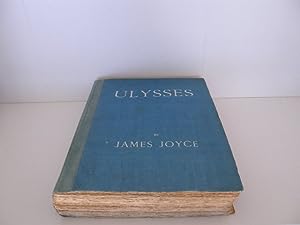
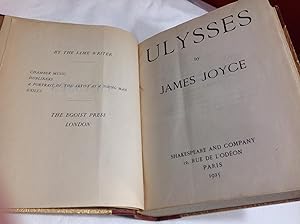


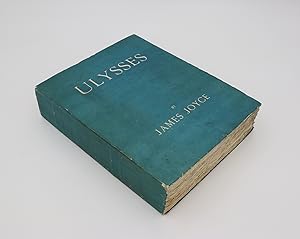


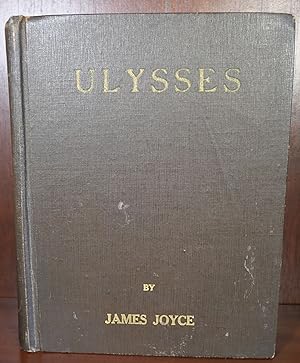

![Immagine del venditore per Ulysses. by James Joyce [First UNAUTHORISED US Edition - PIRATED ~ Full Leather Binding] venduto da Louis88Books (Members of the PBFA)](https://pictures.abebooks.com/inventory/md/md31683169517.jpg)

